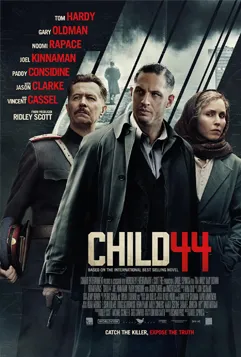Historical accuracy of Child 44

Historical accuracy of Child 44

Characters
Leo Demidov (Tom Hardy)
A fictional protagonist. His character arc explores the conflict between state loyalty and personal conscience within the repressive Stalinist system. He is not based on a real investigator from the 1950s.
Raisa Demidova (Noomi Rapace)
A fictional character representing the fear and compromises ordinary citizens faced, particularly those connected to state officials.
General Mikhail Nesterov (Gary Oldman)
A fictional character representing local authority who eventually helps Leo, perhaps suggesting some pragmatism existed outside the central MGB apparatus.
Vasili Nikitin (Joel Kinnaman)
A fictional antagonist embodying the cruelty, paranoia, and careerism fostered within the state security services.
Major Kuzmin (Vincent Cassel)
Fictional character representing MGB leadership enforcing state doctrine.
Alexei Andreyev (Paddy Considine)
Fictional character representing victims of MGB persecution.
More characters
Ivan Sukov (Nikolaj Lie Kaas)
Fictional character, part of Leo's MGB unit.
The Killer (Unnamed/Vladimir Malevich)
The pattern of crimes (child murders near railway lines, specific mutilations) is inspired by Andrei Chikatilo. However, Chikatilo operated decades later, and this character/timeline is fictional.
Story
Existence of a serial child killer in USSR in 1953
The core plot driver - this specific series of child murders happening in 1953 - is fictional, transposed from the later Chikatilo case (1978-1990) into the Stalinist era by the novelist.
Setting in Stalinist Soviet Union (early 1950s)
The film accurately depicts the timeframe just before Stalin's death, a period known for intense political repression, paranoia, and the power of the state security (MGB).
Holodomor (Ukrainian Famine) shown in backstory
The film briefly references Leo's childhood survival during the Holodomor (1932-33), a real man-made famine that caused millions of deaths.
MGB operations (surveillance, arrests, denunciations)
Accurately portrays the pervasive role and brutal methods of the Ministry of State Security (MGB) in suppressing dissent and maintaining state control through fear.
Official denial of crime ("No murder in paradise")
Accurately reflects the Soviet ideological stance that systemic crime, especially serial murder, was a capitalist phenomenon and theoretically impossible in a communist state. This denial did hinder real investigations later on (e.g., Chikatilo).
Investigation hindered by political ideology/MGB interference
While the specific case is fictional for 1953, the difficulty of investigating crimes that contradicted state ideology, and interference from security services, was a real phenomenon in the Soviet system.
Atmosphere of fear and paranoia among citizens
Effectively conveys the pervasive climate of fear, suspicion, and the danger of dissent characteristic of life under Stalinism.
Use of exile/demotion as punishment
Demoting and exiling officials or citizens who fell out of favor to remote provincial posts was a common practice in the Soviet system.
Reichstag flag raising depiction
The opening scene references the iconic 1945 photo, including the detail about the soldier initially wearing multiple (looted) watches, which caused Stalin to order a restaging/retouching of the photo.
Setting
Soviet Union (Early 1950s)
Creates a visually bleak, oppressive, and utilitarian atmosphere consistent with the late Stalinist era, emphasizing state control and scarcity. (Filmed mainly in Czech Republic).
Moscow Architecture
Features imposing Stalinist architecture, communal apartments, and MGB headquarters, contributing to the period feel.
Provincial Towns (e.g., Volsk)
Contrasts Moscow with smaller, perhaps more dilapidated industrial towns, reflecting the diversity of Soviet life while maintaining an atmosphere of state control.
State Orphanages
Briefly depicts orphanages reflecting harsh conditions, a reality following war and political turmoil.
Railways
Railways feature prominently (linking crime scenes) and are depicted with period-appropriate trains and infrastructure, central to Soviet transportation.
Clothing and Uniforms
Costumes for civilians appear suitably drab and functional for the era. MGB uniforms and military attire seem appropriate for the early 1950s.
Vehicles and Technology
Cars, trucks, telephones, and other technology shown align with what was available in the Soviet Union in the early 1950s.
Atmosphere of Oppression and Conformity
The film successfully conveys the pervasive sense of state surveillance, lack of privacy, fear of authority, and pressure to conform that characterized the late Stalinist period.
